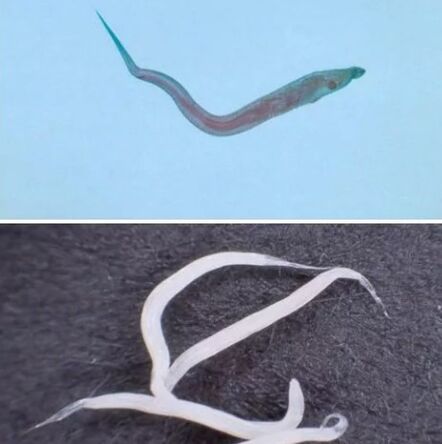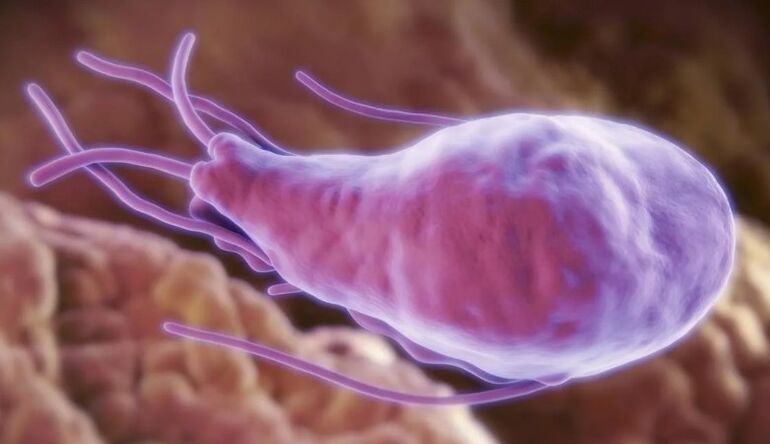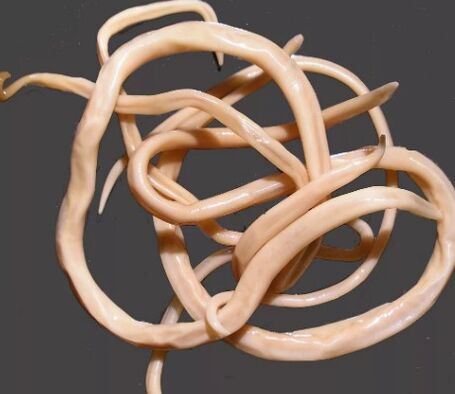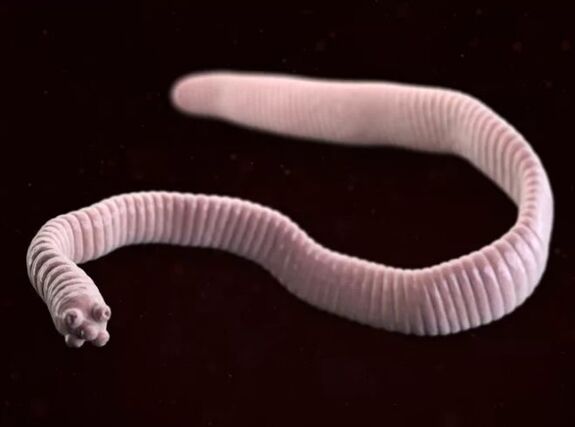The types of parasites in the human body are very diverse.In addition to multiple cells and protozoa, viruses, bacteria and fungi are also included, which are parasitic due to the human body, although in the medical tradition of viruses and bacteria, it is not customary to attribute to parasites.

In the human body, it is generally believed that different types of parasites are located not only in the intestine, but also localized in many other organs: in the blood, muscle tissue, joints, brain (head, spine and spine), and even in the eyes.
Internal organs such as the gastrointestinal tract, liver, lungs, and heart are particularly affected.
The stay of parasites in the human body is far from harmless.First, their harmful effects are that they absorb a considerable portion of the useful substance from food, without which the full function of the body is impossible.
The general poisoning of humans has also exacerbated this imbalance due to toxins secreted by parasites, which may lead to the development of many diseases into malignant tumors.Usually, diseases caused by parasites can be chronic.
The special danger is that parasitic diseases can cause other (usually usually intestinal infections) characteristics, so timely differential diagnosis is crucial to detect parasite types and develop adequate therapeutic strategies.
Generally, the types of human parasites can be divided into two large groups:
- bone rocks, parasitize on the surface of the body and feed people (worms, fleas, lice, ticks); used as carriers of pathogens such as encephalitis, typhoid, anthrax;
- Endoparasits, parasites, parasites on internal organs, leading to serious diseases; among them, the simplest (giardia, amoeba, caterpillar, toxin) and worm-parasits (worms).
Classification of Parasites

Let us consider the main types of human endoparasitics in more detail.Many of them only see under a microscope, especially some of the appearances in worms, which are amazing in size.Let's start with the simplest:
- Lajambia and the causes of malnutrition are also causes of in vivo anemia, anemia and general poisoning.
- Toxoplasma gondii can affect the brain, eyes, myocardium, and nervous system, but they are particularly dangerous to pregnant women due to the risk of fetal death or its severe lesions.
- Amoeba can cause amoeba dysentery, elastic encephalitis and other dangerous diseases.
- trichomonas is the source of infectious diseases of the genital system.
The most common parasites
Of course, the most common nepasite includes worms (worms), which, according to various sources, infects more than 80% of the planet's population.
There are a large number of these parasites classified into the main types:
- nematodes - round worms (Ascarides, Pinworms, Trichinelles, Vlasov, etc.);
- Cestodes - Ribbon worms (ribbons, pork and cattle taps, echinococcus, etc.);
- Trematodes - Carpet workers (liver, blood, lungs, and dishes that live in the intestines).
Sometimes you will find a more general classification according to which all types of parasites are divided into:
- Intestine, parasites of the intestine;
- Tissue, located in other organs and tissues.
However, at different stages of its life cycle, most worms experience symptoms, and develop both tissue and intestines.
Consider a brief description of the most common types of worm types.
Circular Worms (Nematodes)
- Askarids - The most common worms worms with lengths of 20 to 40 cm are parasitic in the small intestine, but are moved in the human body, affecting the circulatory and respiratory system.In addition to the intestine, these parasites can also be found in the liver and gallbladder, heart and lungs.A common symptom of anaerobic disease is an allergic reaction.
- Speaker - Small worms with a maximum of 1 cm affect the intestines and cause diseases such as enteritis, intestinal tract, fatigue, sleep disorders, etc.The characteristic sign of pinworms' existence is itching in the anus, and they lay eggs.
- Trichinella - These microscopic worms (their size is only a few millimeters) cause serious illness - trichomoniasis, which can lead to death without treatment.Adult species live in the human body (breathing, face, etc.) in the muscles, causing muscle pain, fever, edema, and allergic rash on the skin.
- Blacovyv - Small worms (up to 4.5 cm in length, front part of the body

cause diarrhea, acute abdominal pain and other appendicitis-like larvae. Anemia develops due to body intoxication.
Ribbon worms (Cestodes)
- Wide tape Its body length reaches 10 m, leading to the development of dicytosis, nausea, weakness, vomiting, unstable feces, unscrupulous diseases and anemia.
- Pork tap Its length is 3 to 8 m, mainly parasitizes in the small intestine and causes two diseases immediately: tail diseases with disorders, manic, neurological and abdominal syndromes, as well as poisoning, intestinal, allergic and respiratory syndrome. Depends on the positioning of Tsistitserki, muscles, brain, heart, eyes, etc.
- Cattle cone, whose length can reach up to 18 m, can cause tusirinchosis, is considered one of the most dangerous types of worms.If descensoring does not do this, it can live in humans under 18-20 years old!It is located in the large intestine, causing its important active products as well as diarrhea, nausea, vomiting, abdominal pain, anemia, anemia, allergic reactions, and neurological problems.
- Dwarf Tabel Only 1.5-5 cm in length is the source of membranous debilitation of inflammatory, painful and agitated neuropathic syndrome, the digestive and nervous system in the body, as well as the digestive and nervous system of the liver.
- echinococcus It is considered the smallest ribbon flax - its length is only 2.5 to 8, rarely 9 mm, but its infection has huge consequences in the form of liver and lung damage, forming cysts and tumors, resulting in dysfunction of these organs.

Dosal Worker (Trematodes)
- Hepatic Fluorine or Hepatic Double Gun This shape is similar to 30-50 mm long and 8-13 mm wide with suction cups.It damages the liver membrane and blocks the bile ducts, which can completely prevent the outflow of bile.It can cause cirrhosis, jaundice and liver cancer.
- Cat (Siberian) fluke or cat double fruit , flat GEON with 4-13 mm long.Positioning - the ducts of the gallbladder, liver and pancreas.It can cause gastritis, ulcers, pancreatitis, cholecystitis, and the development of liver cancer, which can lead to death.
- Lungs and lungs It has an egg-shaped, a reddish-brown body with long spikes, a length of 7.5 to 12 mm and a width of 4-8 mm.It affects the lungs and causes inflammation, exudative pleuritis, focal fibrosis and lung cancer.With the penetration of encephalitis and meningeencephalitis.
- Schistosomiasis (blood dish) - Isolated worms, 1-2 cm in size, their eggs will cause increased liver, spleen and lymph nodes, formation of polyps in the intestines, diarrhea, granulomatous inflammation, and bladder cancer.
Source of infection

Worm disease can cause many health problems, thus reducing life for 15-25 years.Many parasites are difficult to detect.They can be anywhere - blood, intestines, lungs, heart, brain.Symptoms of worm invasion can be confused with acute respiratory virus infection, gastrointestinal disease and other symptoms.In this case, the main mistake is tightening!If you suspect parasites, you need to contact an expert.If we talk about drugs and independent treatments, the antiparasitic complex is suitable for the most common worms (Ascaris, Pinworms, chains).
Like other intestinal diseases, worm disease is usually a "dirty hand disease" that causes the eggs and worms of worms in the human body.
- When they do not wash their hands in the toilet and before eating;
- Do not wash raw vegetables, fruits and herbs;
- Do not heat treatment of meat and fish enough;
- When incorrect salt fish and fats consumed;
- Leave the prepared foods available for flies and cockroaches;
- Use feces as fertilizer in garden plots;
- Bath in unplanned reservoirs;
- Contact with homeless animals.

However, from pets, you can also be infected by worms, because animals often provide intermediate hosts for worms, and the main owner is a person.
The method of struggle
- From a very young age to instilling the habit of washing hands in children.They need to do this more often as they constantly add sand, earth, puddles, where eggs and parasite larvae are most favorable to contact with domestic and street animals.
- When any disease occurs, embryopathy cannot be ruled out, so it is recommended to perform proper testing of parasites to determine a specific worm type (most drugs have medications.
- If parasites are found in a family member, everything should be drugged to cause worm disease.
- Folk medicine knows that there are many ways to get rid of worms and will produce good results.
- Do not leave prepared dishes, breads, pastries, etc. for flies or cockroaches - vectors for worm eggs -Don't put them on the product.
- Add to carefully observe the temperature state during cooking: meat and fish, often found worm eggs, cooked/fried/baked.
- Rinse vegetables, fruits, greens in running wells, which are consumed by birth.
- Perform deworming pets regularly.
- Refuse feces to use feces as fertilizer on garden land.
- When traveling to exotic countries, be very cautious about local dishes, especially those offered on the street, so there is no guarantee that you won't pick up any exotic fears with them.



























